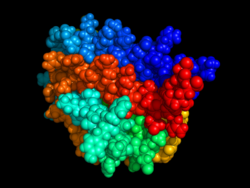Epub ahead of print: Hagemeyer et al. Erythropoietin attenuates neurological and histological consequences of toxic demyelination in mice. Mol Med. 2012 Feb 29. doi: 10.2119/molmed.2011.00457.
Background: Erythropoietin (EPO) reduces symptoms of experimental autoimmune encephalomyelitis (EAE) in rodents and shows neuroregenerative effects in chronic progressive MS. EPO's mechanisms of action in these conditions with shared immunological etiology are unclear.
Method and results: These investigators, therefore, employed a model of toxic demyelination allowing exclusion of T-cell mediated inflammation (autoimmune inflammation). In a 'double-blind' (for food/injections), placebo-controlled, longitudinal 4-arm design, 8-week old C57BL/6 mice (n=26/group) were assigned to cuprizone-containing (0.2%) or regular food (ground chow) for 6 weeks.
"Wow a blinded animal study; like-minded animal researchers or MouseDoc's guidelines must be getting through to the research community."
After 3 weeks, mice were injected every other day with placebo or EPO (5,000 IU/kg intraperitoneally) until end of cuprizone feeding. Half of the mice were exposed to behavioral testing, MRI and histology immediately after treatment cessation, whereas the other half were allowed a 3-week treatment-free recovery. Immediately after termination of cuprizone feeding, all toxin-exposed mice were compromised regarding vestibulomotor function/coordination, with EPO treated animals performing better than placebo. Likewise, ventricular enlargement (atrophy or shrinkage of the brain) after cuprizone as documented by MRI was less pronounced upon EPO. After 3-week recovery, remarkable spontaneous improvement was observed in all mice with no measurable further benefit in the EPO group ('ceiling effect'). Histological analysis (microscopic) of the corpus callosum revealed attenuation by EPO of the cuprizone-induced increase in microglial numbers (scavenger cells that clear up the debris) and amyloid precursor protein accumulations (marker of axonal transection) as readout of inflammation and axonal degeneration.
Conclusion: EPO ameliorates neurological symptoms in the cuprizone model of demyelination possibly by reduction of inflammation-associated axonal degeneration in white matter tracts. These findings underscore the value of future therapeutic strategies for multiple sclerosis based on EPO/EPO variants.
"These results are promising. EPO is something we have worked on as well. The problem is that it is associated with off target effects that have been linked to the development of cancers. Despite this there is a clinical trial that is currently recruiting in Denmark: The Effects of Erythropoietin on Clinical Disability and Brain Pathology in Patients With Progressive Multiple Sclerosis (EPO-ProgMS). Some of the new EPO analogues are more promising and are in early phase 2 development as neuro or cell protective factors in other indications."
"Unfortunately, EPO and EPO analogues are a long way off from the clinic; possibly decades. So may be we shouldn't get too excited."
Additional reading: EPO
CoI: nil
